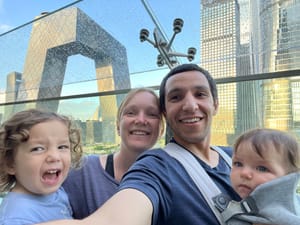Have you ever heard of the Mid-Autumn Festival? It's one of the most important holidays in China.
Every year, when the moon is at its fullest and brightest, Chinese families come together to celebrate. This festival is all about family, delicious food, and appreciating the beauty of the moon.
The Mid-Autumn Festival has been around for over 3,000 years. It started as a way to give thanks for the harvest. Over time, it became linked with the moon and family togetherness. There's even a famous story about a moon goddess named Chang'e that goes with the festival!
Mid-Autumn Festival is celebrated on the 15th day of the 8th lunar month.
In 2024 it is 17th September, which gives us a bit of time to learn about the festival.
The Legend of Chang'e
One of the most beloved stories associated with the Mid-Autumn Festival is the legend of Chang'e, the moon goddess. Here's how the tale goes:
Long ago, there were ten suns in the sky. They scorched the earth, making life unbearable. A skilled archer named Hou Yi shot down nine of the suns, saving humanity. As a reward, he received a pill of immortality from the Queen of Heaven.
Hou Yi didn't want to leave his beautiful wife, Chang'e, so he didn't take the pill right away. He asked Chang'e to keep it safe. But one day, while Hou Yi was out hunting, his apprentice tried to steal the pill. To keep it from falling into the wrong hands, Chang'e swallowed it herself.
The pill made Chang'e float up into the sky. She kept going higher and higher until she reached the moon. There, she became the goddess of the moon. Hou Yi was heartbroken. Every year on the night of the full moon, he would put out Chang'e's favorite foods and gaze at the moon, hoping to see her.
People say that's why we eat special foods and look at the moon during the Mid-Autumn Festival. It's a way to remember this old story of love and sacrifice.
How China Celebrates
In China, the Mid-Autumn Festival is a big deal. Families try their best to get together, kind of like Thanksgiving in the U.S. You'll see streets decorated with colorful lanterns and moon-shaped designs. Many cities have special events, like lantern shows or moon-viewing parties in parks.
One of the coolest things about the festival in China is how each region adds its own twist. In Guangzhou, for example, people eat special rice balls. In Nanjing, they float river lanterns. No matter where you are in China, though, you'll find people enjoying mooncakes and gazing at the moon with their loved ones.
The Festival Around the World
It's not just China that celebrates the Mid-Autumn Festival. Other countries join in too! In Vietnam, they call it Tết Trung Thu and it's especially fun for kids. They wear masks and carry lanterns in parades. Taiwan, Hong Kong, Singapore, and Malaysia also have their own ways of marking the day.
In these places, you'll find a mix of old and new traditions. Some folks stick to the old customs, while others add modern twists. For example, in Singapore, you might find mooncakes filled with ice cream instead of traditional bean paste!
Bringing the Festival Home
Want to join in the fun? You don't need to be in China to celebrate! Here are some ideas:
- Get some mooncakes: These round pastries are the must-have food for the festival. You can find them in Asian grocery stores or even make your own.
- Decorate with lanterns: Hang up some paper lanterns to create a festive mood.
- Have a moon-viewing party: Invite friends over to admire the full moon together. Share some tea and mooncakes while you're at it.
- Learn about Chinese culture: Use this time to watch a Chinese movie or learn a few words in Mandarin.
- Make it a family night: The heart of the festival is about being with family. So, plan a special dinner and spend time with your loved ones.
Wishing Happy Mid-Autumn Festival in Chinese
Want to impress your Chinese friends or add an authentic touch to your celebration? Learn how to say "Happy Mid-Autumn Festival!" in Chinese! Here are a few common greetings:
- The most common and simple greeting is "中秋节快乐" (Zhōngqiū jié kuàilè). Here's how to pronounce it:This phrase literally means "Mid-Autumn Festival Happy".
- Another popular greeting is "祝你中秋快乐" (Zhù nǐ Zhōngqiū kuàilè), which means "Wish you a happy Mid-Autumn Festival".
- If you want to wish someone a happy holiday and a reunion with their family, you can say "中秋节快乐,阖家团圆" (Zhōngqiū jié kuàilè, hé jiā tuán yuán). This means "Happy Mid-Autumn Festival, may your family be reunited".
Remember, even if your pronunciation isn't perfect, your Chinese friends will appreciate the effort! It's a great way to show your interest in the culture and join in the festive spirit.
Festival Foods
We can't talk about the Mid-Autumn Festival without mentioning food! Mooncakes are the star of the show. These dense, round pastries are usually filled with lotus seed paste and may have a salted egg yolk in the center to represent the moon.
But there's more than just mooncakes. People also enjoy pomelos (a citrus fruit that looks like a big grapefruit), taro, and other seasonal treats. In some places, families gather to make mooncakes together, turning it into a fun activity.
Traditions and Customs
Besides eating, there are other important customs. Moon gazing is a big one. Families often sit outside to admire the full moon together. Many people also light lanterns or write wishes on them and release them into the sky.
Gift-giving is another tradition. People often give mooncakes to friends and family as a way of wishing them happiness and good fortune.
The Modern Mid-Autumn Festival
Like many old traditions, the Mid-Autumn Festival has changed over time. In big cities, you might see huge light shows or moon-themed art installations. Some people now send digital greetings instead of physical mooncakes.
But even with these changes, the core of the festival remains the same. It's still about family, gratitude, and taking a moment to appreciate the beauty around us.
So, the next time you see a full moon, think about the millions of people gathering with their families to celebrate the Mid-Autumn Festival. Maybe you'll even feel inspired to start your own moon-viewing tradition!





Member discussion